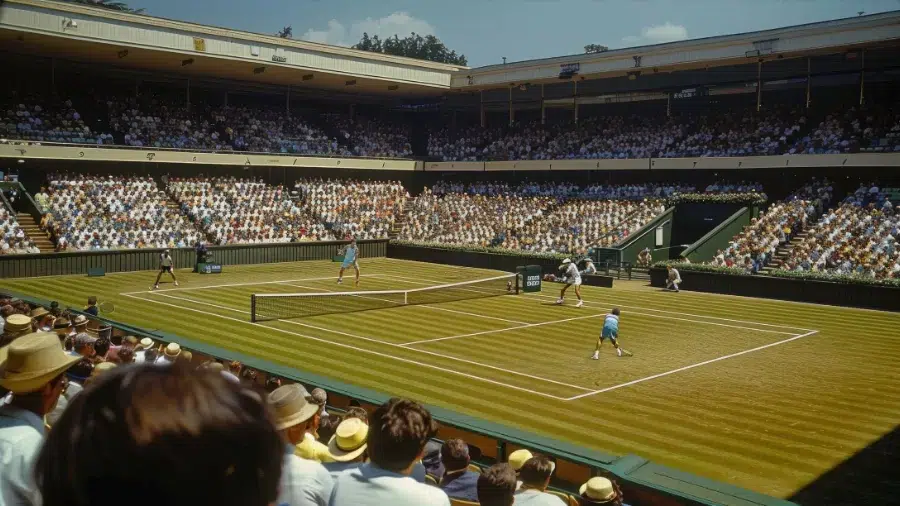Sports
Is Technology Enhancing or Hurting the Drama of Sports?

- Technology in sports, like Hawk-Eye and VAR, has improved accuracy and fairness but has also sparked debates about its impact on drama and excitement.
- While innovations enhance the viewing experience and reduce errors, they can disrupt the natural flow of games and lessen the tension.
- The future of sports lies in finding a balance between technological accuracy and preserving the raw, emotional moments that captivate fans.
Sports have long been associated with passion, ability, and those unexpected moments that keep spectators on the tip of their seats. However, with the increasing impact of technology in sports, the substance of this drama appears to be changing. From cutting-edge analysis in Wimbledon tennis matches to the contentious usage of Video Assistant referees (VAR) in football, technology’s impact on the sporting world is evident. The basic question remains: Does technology reduce the drama of sports, or does it improve the experience for both players and spectators?
Innovations That Are Transforming the Game
The incorporation of technology into sports has accelerated dramatically during the last few decades. Innovations such as Hawk-Eye in tennis, Decision Review System (DRS) in cricket, and VAR in football have dramatically enhanced game accuracy and fairness. In tennis, Hawk-Eye provides an accurate way to resolve contested line calls, giving players and viewers clarity that was previously impossible. Cricket’s DRS has changed the sport by allowing players to question on-field judgements, while football’s VAR has been implemented by major leagues to assist referees in making precise decisions.
The Impact of Drama and Excitement
However, while technological improvements have made sports more equitable, they have also raised controversy about the impact on the drama and excitement that spectators seek. One of the primary objections levelled at VAR is that it disturbs the natural flow of football matches, with prolonged reviews breaking the rhythm and lowering the excitement. In tennis, Hawk-Eye has reduced the number of challenged calls, resulting in fewer moments of stress and ambiguity that used to provide a distinct flavour to matches.
Improving The Viewing Experience
Regardless of the complaints, technology’s influence in improving sports cannot be underestimated. For example, VAR has helped to eliminate officiating errors in football, resulting in more equitable outcomes. Hawk-Eye has increased tennis players’ trust inline calls, allowing them to focus more on their game. Furthermore, technology has transformed the way spectators interact with sports. The proliferation of live streaming, video on demand, and social media has enabled fans to stay in touch with their favourite teams and athletes no matter where they are in the world. This improved accessibility has helped to drive the global growth of sports.
Striking a Balance of Accuracy and Emotion
The true issue for sports regulating bodies is finding a balance between accuracy and drama. Maintaining justice in sports is critical, but so is preserving the thrill that draws spectators back for more. Potential remedies could include limiting the number of reviews in a match or establishing severe time limitations on these reviews to keep them from slowing down the game.
The Impact of Technology on Classic Sports Moments
Technology has long been a component of sports, delivering advances that improve both performance and spectator enjoyment. Wimbledon, the world’s oldest tennis championship, features Hawk-Eye technology, which uses high-speed cameras to track the ball’s movement and position. This precision has resulted in more consistent outcomes, yet some argue that it has removed the suspense associated with disputed queue calls.
VAR’s Impact on Football Drama
VAR in sports has also been the subject of heated debate. While it seeks to fix errors in goal, penalty, and red card rulings, its frequent use has been chastised for disrupting the game’s natural flow. Fans frequently express irritation with the lengthy pauses as referees analyse film, which can diminish the intensity of live moments. Some feel that this reliance on technology takes away the genuine, unvarnished enthusiasm that makes football so appealing.
The Future of Technology in Sport
As technology advances, its influence on sports is expected to rise. Artificial intelligence, machine learning, virtual reality, and smart wearables are already changing the way players prepare, games are analysed, and fans interact with sports. AI can predict player moves and assist in minimising injuries, while VR can provide fans with immersive, game-like experiences from their own homes. Although these developments promise to revolutionise sports, there are concerns that they will make gaming too predictable, eliminating the spontaneity that makes sports so appealing.
Preserving the Spirit of Competition
Finding a balance between technology and the raw qualities of sport may be the key to retaining the unique exhilaration that keeps spectators interested. Sports governing organisations must explore how to best integrate technology while preserving the thrilling moments that define the essence of competition. Sports are about more than just truth and justice; they are about the emotional highs and lows, the stories of underdogs, and the magic that occurs when talent meets chance.

















































